2013 BMW 535I XDRIVE GRAN TURISMO engine
[x] Cancel search: enginePage 217 of 240
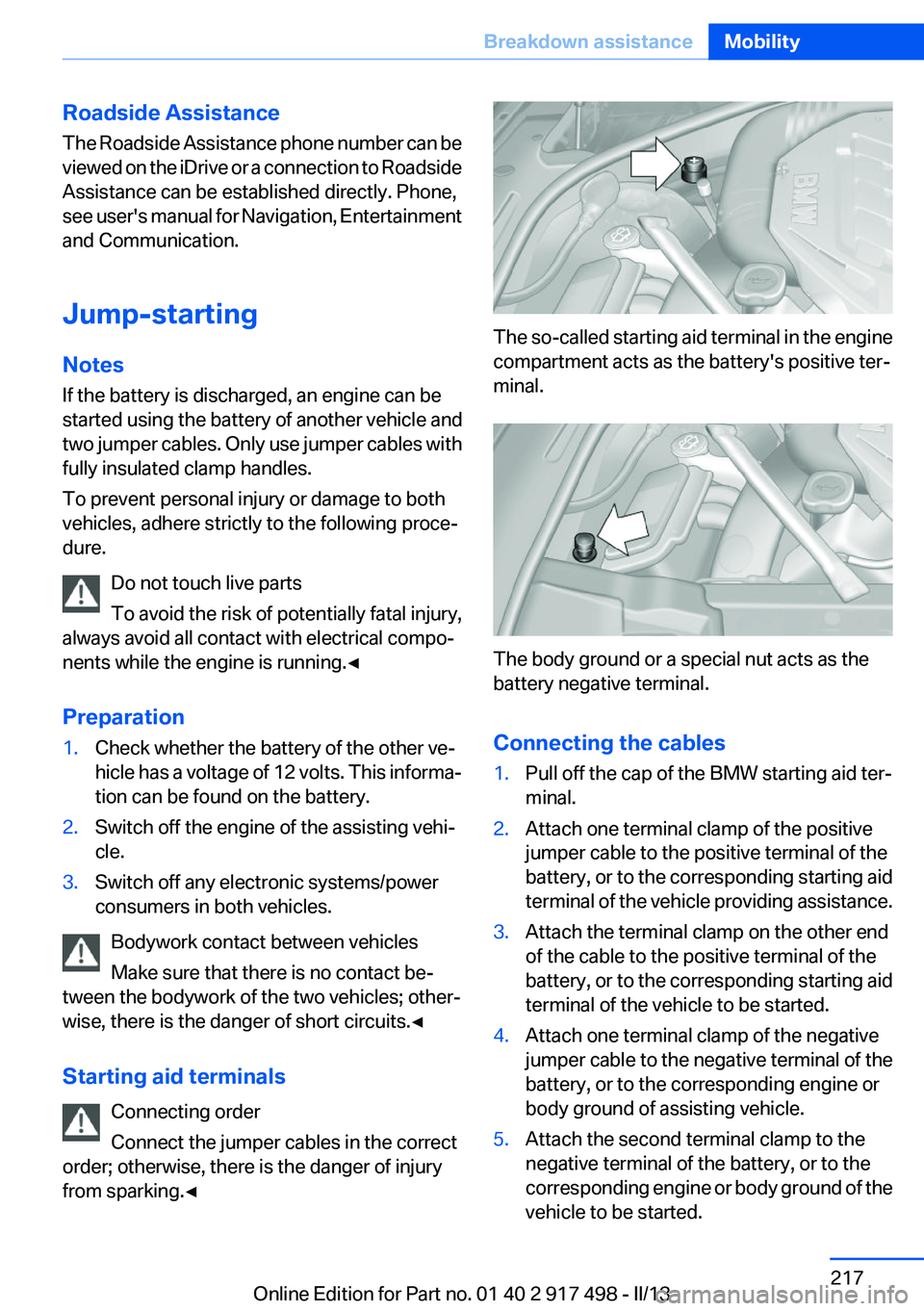
Roadside Assistance
The Roadside Assistance phone number can be
viewed on the iDrive or a connection to Roadside
Assistance can be established directly. Phone,
see user's manual for Navigation, Entertainment
and Communication.
Jump-starting
Notes
If the battery is discharged, an engine can be
started using the battery of another vehicle and
two jumper cables. Only use jumper cables with
fully insulated clamp handles.
To prevent personal injury or damage to both
vehicles, adhere strictly to the following proce‐
dure.
Do not touch live parts
To avoid the risk of potentially fatal injury,
always avoid all contact with electrical compo‐
nents while the engine is running.◀
Preparation1.Check whether the battery of the other ve‐
hicle has a voltage of 12 volts. This informa‐
tion can be found on the battery.2.Switch off the engine of the assisting vehi‐
cle.3.Switch off any electronic systems/power
consumers in both vehicles.
Bodywork contact between vehicles
Make sure that there is no contact be‐
tween the bodywork of the two vehicles; other‐
wise, there is the danger of short circuits.◀
Starting aid terminals Connecting order
Connect the jumper cables in the correct
order; otherwise, there is the danger of injury
from sparking.◀
The so-called starting aid terminal in the engine
compartment acts as the battery's positive ter‐
minal.
The body ground or a special nut acts as the
battery negative terminal.
Connecting the cables
1.Pull off the cap of the BMW starting aid ter‐
minal.2.Attach one terminal clamp of the positive
jumper cable to the positive terminal of the
battery, or to the corresponding starting aid
terminal of the vehicle providing assistance.3.Attach the terminal clamp on the other end
of the cable to the positive terminal of the
battery, or to the corresponding starting aid
terminal of the vehicle to be started.4.Attach one terminal clamp of the negative
jumper cable to the negative terminal of the
battery, or to the corresponding engine or
body ground of assisting vehicle.5.Attach the second terminal clamp to the
negative terminal of the battery, or to the
corresponding engine or body ground of the
vehicle to be started.Seite 217Breakdown assistanceMobility217
Online Edition for Part no. 01 40 2 917 498 - II/13
Page 218 of 240
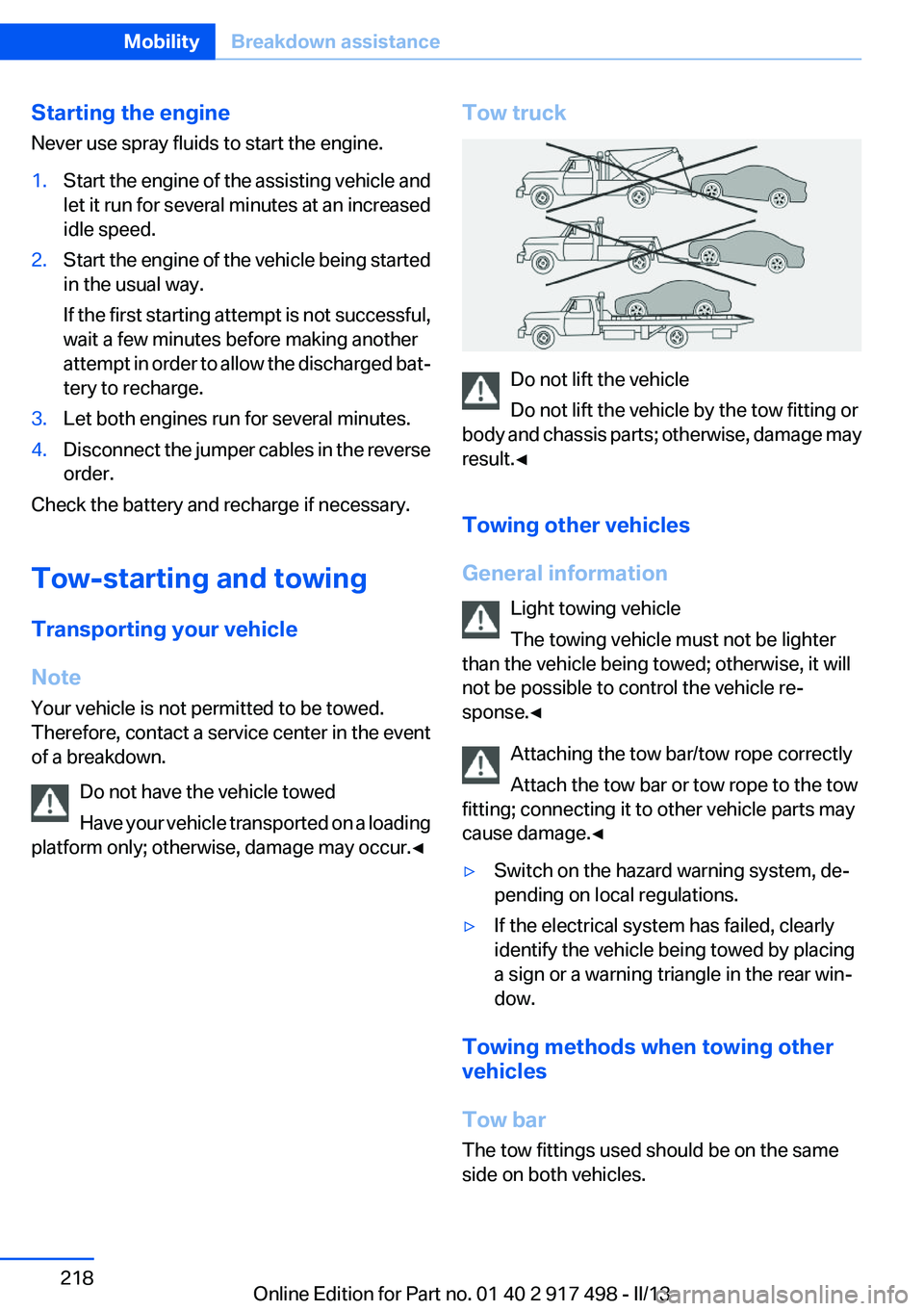
Starting the engine
Never use spray fluids to start the engine.1.Start the engine of the assisting vehicle and
let it run for several minutes at an increased
idle speed.2.Start the engine of the vehicle being started
in the usual way.
If the first starting attempt is not successful,
wait a few minutes before making another
attempt in order to allow the discharged bat‐
tery to recharge.3.Let both engines run for several minutes.4.Disconnect the jumper cables in the reverse
order.
Check the battery and recharge if necessary.
Tow-starting and towing
Transporting your vehicle
Note
Your vehicle is not permitted to be towed.
Therefore, contact a service center in the event
of a breakdown.
Do not have the vehicle towed
Have your vehicle transported on a loading
platform only; otherwise, damage may occur.◀
Tow truck
Do not lift the vehicle
Do not lift the vehicle by the tow fitting or
body and chassis parts; otherwise, damage may
result.◀
Towing other vehicles
General information Light towing vehicle
The towing vehicle must not be lighter
than the vehicle being towed; otherwise, it will
not be possible to control the vehicle re‐
sponse.◀
Attaching the tow bar/tow rope correctly
Attach the tow bar or tow rope to the tow
fitting; connecting it to other vehicle parts may
cause damage.◀
▷Switch on the hazard warning system, de‐
pending on local regulations.▷If the electrical system has failed, clearly
identify the vehicle being towed by placing
a sign or a warning triangle in the rear win‐
dow.
Towing methods when towing other
vehicles
Tow bar
The tow fittings used should be on the same
side on both vehicles.
Seite 218MobilityBreakdown assistance218
Online Edition for Part no. 01 40 2 917 498 - II/13
Page 219 of 240
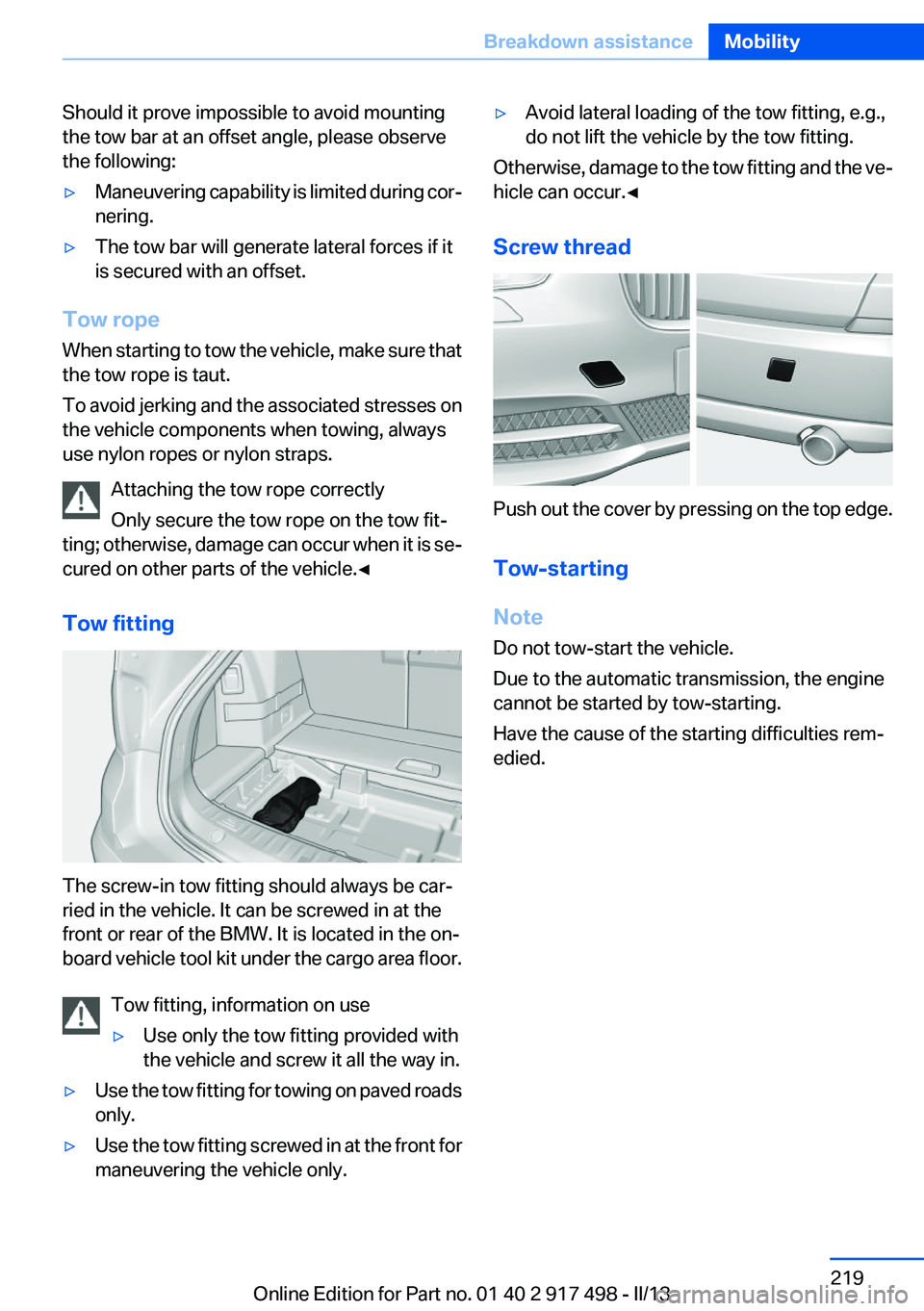
Should it prove impossible to avoid mounting
the tow bar at an offset angle, please observe
the following:▷Maneuvering capability is limited during cor‐
nering.▷The tow bar will generate lateral forces if it
is secured with an offset.
Tow rope
When starting to tow the vehicle, make sure that
the tow rope is taut.
To avoid jerking and the associated stresses on
the vehicle components when towing, always
use nylon ropes or nylon straps.
Attaching the tow rope correctly
Only secure the tow rope on the tow fit‐
ting; otherwise, damage can occur when it is se‐
cured on other parts of the vehicle.◀
Tow fitting
The screw-in tow fitting should always be car‐
ried in the vehicle. It can be screwed in at the
front or rear of the BMW. It is located in the on‐
board vehicle tool kit under the cargo area floor.
Tow fitting, information on use
▷Use only the tow fitting provided with
the vehicle and screw it all the way in.▷Use the tow fitting for towing on paved roads
only.▷Use the tow fitting screwed in at the front for
maneuvering the vehicle only.▷Avoid lateral loading of the tow fitting, e.g.,
do not lift the vehicle by the tow fitting.
Otherwise, damage to the tow fitting and the ve‐
hicle can occur.◀
Screw thread
Push out the cover by pressing on the top edge.
Tow-starting
Note
Do not tow-start the vehicle.
Due to the automatic transmission, the engine
cannot be started by tow-starting.
Have the cause of the starting difficulties rem‐
edied.
Seite 219Breakdown assistanceMobility219
Online Edition for Part no. 01 40 2 917 498 - II/13
Page 221 of 240
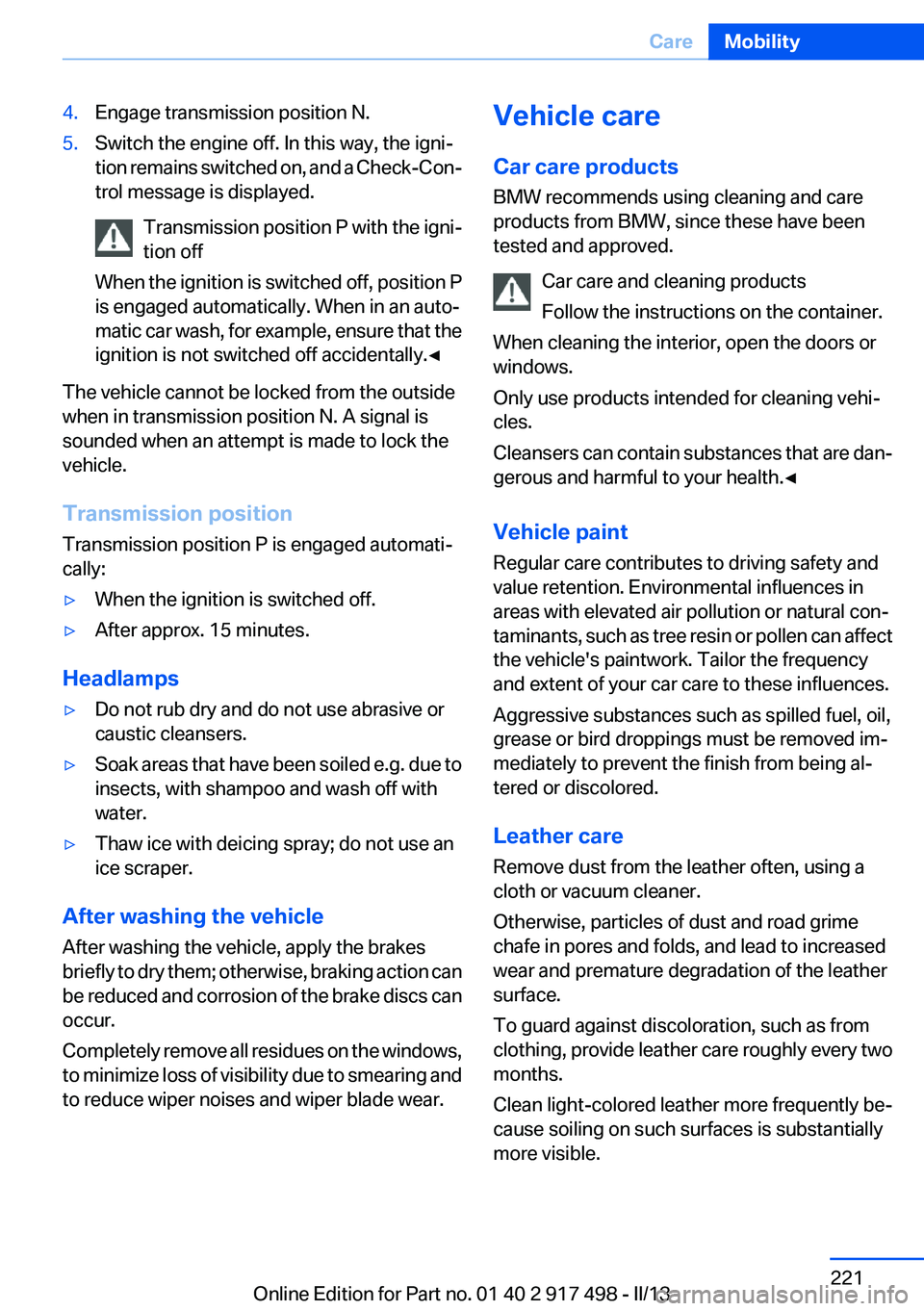
4.Engage transmission position N.5.Switch the engine off. In this way, the igni‐
tion remains switched on, and a Check-Con‐
trol message is displayed.
Transmission position P with the igni‐
tion off
When the ignition is switched off, position P
is engaged automatically. When in an auto‐
matic car wash, for example, ensure that the
ignition is not switched off accidentally.◀
The vehicle cannot be locked from the outside
when in transmission position N. A signal is
sounded when an attempt is made to lock the
vehicle.
Transmission position
Transmission position P is engaged automati‐
cally:
▷When the ignition is switched off.▷After approx. 15 minutes.
Headlamps
▷Do not rub dry and do not use abrasive or
caustic cleansers.▷Soak areas that have been soiled e.g. due to
insects, with shampoo and wash off with
water.▷Thaw ice with deicing spray; do not use an
ice scraper.
After washing the vehicle
After washing the vehicle, apply the brakes
briefly to dry them; otherwise, braking action can
be reduced and corrosion of the brake discs can
occur.
Completely remove all residues on the windows,
to minimize loss of visibility due to smearing and
to reduce wiper noises and wiper blade wear.
Vehicle care
Car care products
BMW recommends using cleaning and care
products from BMW, since these have been
tested and approved.
Car care and cleaning products
Follow the instructions on the container.
When cleaning the interior, open the doors or
windows.
Only use products intended for cleaning vehi‐
cles.
Cleansers can contain substances that are dan‐
gerous and harmful to your health.◀
Vehicle paint
Regular care contributes to driving safety and
value retention. Environmental influences in
areas with elevated air pollution or natural con‐
taminants, such as tree resin or pollen can affect
the vehicle's paintwork. Tailor the frequency
and extent of your car care to these influences.
Aggressive substances such as spilled fuel, oil,
grease or bird droppings must be removed im‐
mediately to prevent the finish from being al‐
tered or discolored.
Leather care
Remove dust from the leather often, using a
cloth or vacuum cleaner.
Otherwise, particles of dust and road grime
chafe in pores and folds, and lead to increased
wear and premature degradation of the leather
surface.
To guard against discoloration, such as from
clothing, provide leather care roughly every two
months.
Clean light-colored leather more frequently be‐
cause soiling on such surfaces is substantially
more visible.Seite 221CareMobility221
Online Edition for Part no. 01 40 2 917 498 - II/13
Page 230 of 240
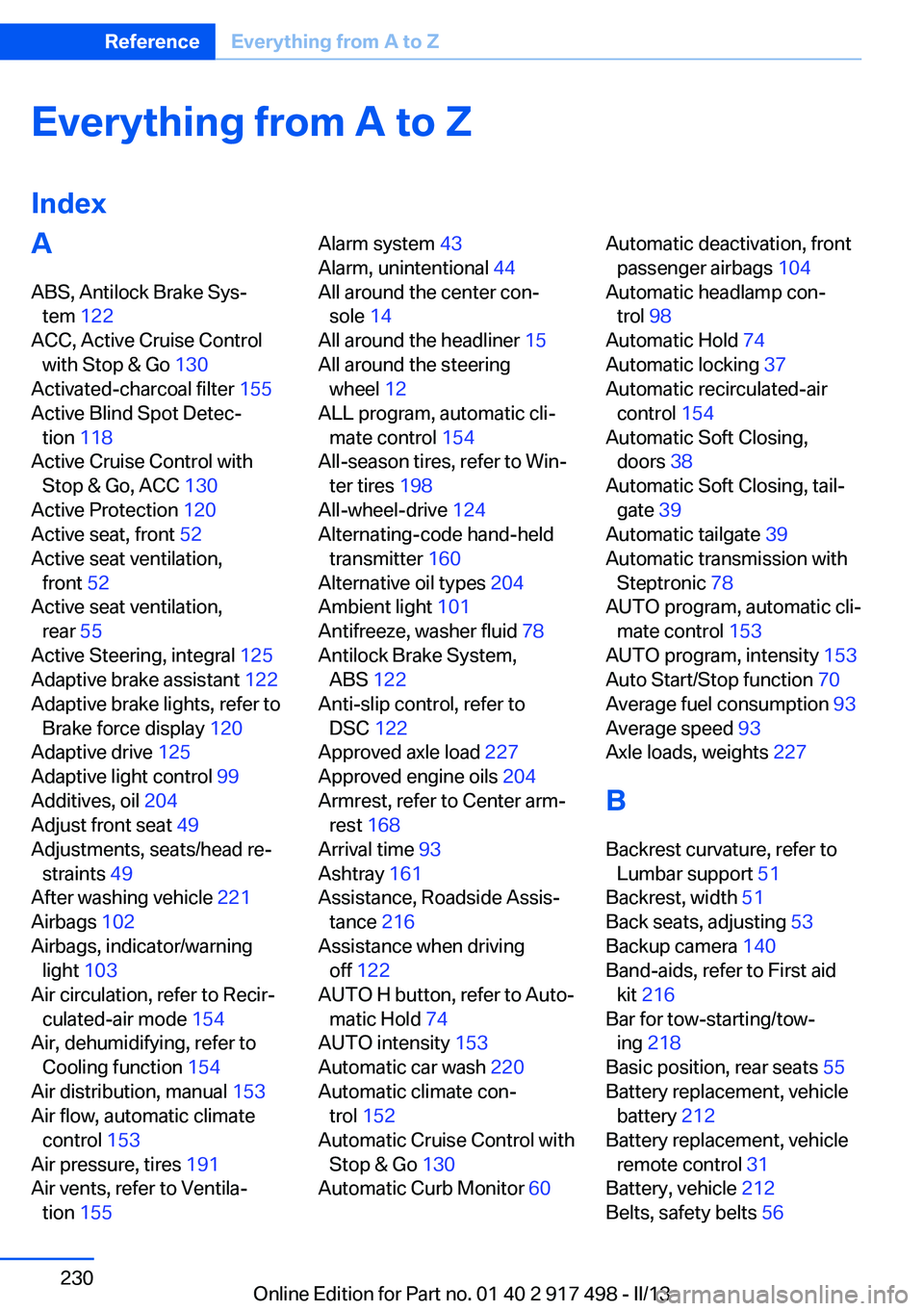
Everything from A to Z
IndexA
ABS, Antilock Brake Sys‐ tem 122
ACC, Active Cruise Control with Stop & Go 130
Activated-charcoal filter 155
Active Blind Spot Detec‐ tion 118
Active Cruise Control with Stop & Go, ACC 130
Active Protection 120
Active seat, front 52
Active seat ventilation, front 52
Active seat ventilation, rear 55
Active Steering, integral 125
Adaptive brake assistant 122
Adaptive brake lights, refer to Brake force display 120
Adaptive drive 125
Adaptive light control 99
Additives, oil 204
Adjust front seat 49
Adjustments, seats/head re‐ straints 49
After washing vehicle 221
Airbags 102
Airbags, indicator/warning light 103
Air circulation, refer to Recir‐ culated-air mode 154
Air, dehumidifying, refer to Cooling function 154
Air distribution, manual 153
Air flow, automatic climate control 153
Air pressure, tires 191
Air vents, refer to Ventila‐ tion 155 Alarm system 43
Alarm, unintentional 44
All around the center con‐ sole 14
All around the headliner 15
All around the steering wheel 12
ALL program, automatic cli‐ mate control 154
All-season tires, refer to Win‐ ter tires 198
All-wheel-drive 124
Alternating-code hand-held transmitter 160
Alternative oil types 204
Ambient light 101
Antifreeze, washer fluid 78
Antilock Brake System, ABS 122
Anti-slip control, refer to DSC 122
Approved axle load 227
Approved engine oils 204
Armrest, refer to Center arm‐ rest 168
Arrival time 93
Ashtray 161
Assistance, Roadside Assis‐ tance 216
Assistance when driving off 122
AUTO H button, refer to Auto‐ matic Hold 74
AUTO intensity 153
Automatic car wash 220
Automatic climate con‐ trol 152
Automatic Cruise Control with Stop & Go 130
Automatic Curb Monitor 60 Automatic deactivation, front
passenger airbags 104
Automatic headlamp con‐ trol 98
Automatic Hold 74
Automatic locking 37
Automatic recirculated-air control 154
Automatic Soft Closing, doors 38
Automatic Soft Closing, tail‐ gate 39
Automatic tailgate 39
Automatic transmission with Steptronic 78
AUTO program, automatic cli‐ mate control 153
AUTO program, intensity 153
Auto Start/Stop function 70
Average fuel consumption 93
Average speed 93
Axle loads, weights 227
B
Backrest curvature, refer to Lumbar support 51
Backrest, width 51
Back seats, adjusting 53
Backup camera 140
Band-aids, refer to First aid kit 216
Bar for tow-starting/tow‐ ing 218
Basic position, rear seats 55
Battery replacement, vehicle battery 212
Battery replacement, vehicle remote control 31
Battery, vehicle 212
Belts, safety belts 56 Seite 230ReferenceEverything from A to Z230
Online Edition for Part no. 01 40 2 917 498 - II/13
Page 232 of 240

Controller 16
Control systems, driving sta‐ bility 122
Convenient opening 35
Coolant 205
Coolant temperature 88
Cooling function 154
Cooling, maximum 153
Cooling system 205
Corrosion on brake discs 176
Cruise control 136
Cruise control, active with Stop & Go 130
Cruising range 89
Cupholder 169
Curb weight 227
Current fuel consumption 89
D
Damage, tires 196
Damping control, dy‐ namic 125
Data, technical 226
Date 89
Daytime running lights 98
Defrosting, refer to Windows, defrosting 153
Dehumidifying, air 154
Destination distance 93
Digital clock 88
Dimensions 226
Dimmable exterior mirrors 61
Dimmable interior rearview mirror 61
Direction indicator, refer to Turn signals 75
Display in windshield 150
Display lighting, refer to Instru‐ ment lighting 100
Displays 81, 82
Displays, cleaning 223
Disposal, vehicle battery 213
Distance control, refer to PDC 138 Distance, selecting for
ACC 132
Distance to destination 93
Divided screen view, split screen 20
Door lock, refer to Remote control 30
Doors, Automatic Soft Clos‐ ing 38
Downhill control 124
Drive-off assistant 122
Drive-off assistant, refer to DSC 122
Driving Dynamics Control 127
Driving instructions, breaking in 174
Driving mode 127
Driving notes, general 174
Driving stability control sys‐ tems 122
Driving tips 174
DSC Dynamic Stability Con‐ trol 122
DTC driving dynamics 123
DTC Dynamic Traction Con‐ trol 123
Dynamic Damping Con‐ trol 125
Dynamic Drive 125
Dynamic Stability Control DSC 122
Dynamic Traction Control DTC 123
E
ECO PRO 181
ECO PRO, bonus range 182
ECO PRO display 181
ECO PRO driving mode 181
ECO PRO mode 181
ECO PRO Tip - driving instruc‐ tion 183
EfficientDynamics 183
Electronic displays, instru‐ ment cluster 82 Electronic Stability Program
ESP, refer to DSC 122
Emergency detection, remote control 31
Emergency release, door lock 37
Emergency release, fuel filler flap 188
Emergency release, parking brake 72
Emergency Request 215
Emergency service, refer to Roadside Assistance 216
Emergency start function, en‐ gine start 31
Emergency unlocking, tail‐ gate 41
Energy Control 89
Energy recovery 89
Engine, automatic Start/Stop function 70
Engine, automatic switch- off 70
Engine compartment 201
Engine compartment, working in 201
Engine coolant 205
Engine oil 203
Engine oil, adding 204
Engine oil additives 204
Engine oil change 204
Engine oil filler neck 204
Engine oil temperature 88
Engine oil types, alterna‐ tive 204
Engine oil types, ap‐ proved 204
Engine start during malfunc‐ tion 31
Engine start, jump-start‐ ing 217
Engine start, refer to Starting the engine 69
Engine stop 69
Engine temperature 88
Entering a car wash 220 Seite 232ReferenceEverything from A to Z232
Online Edition for Part no. 01 40 2 917 498 - II/13
Page 233 of 240
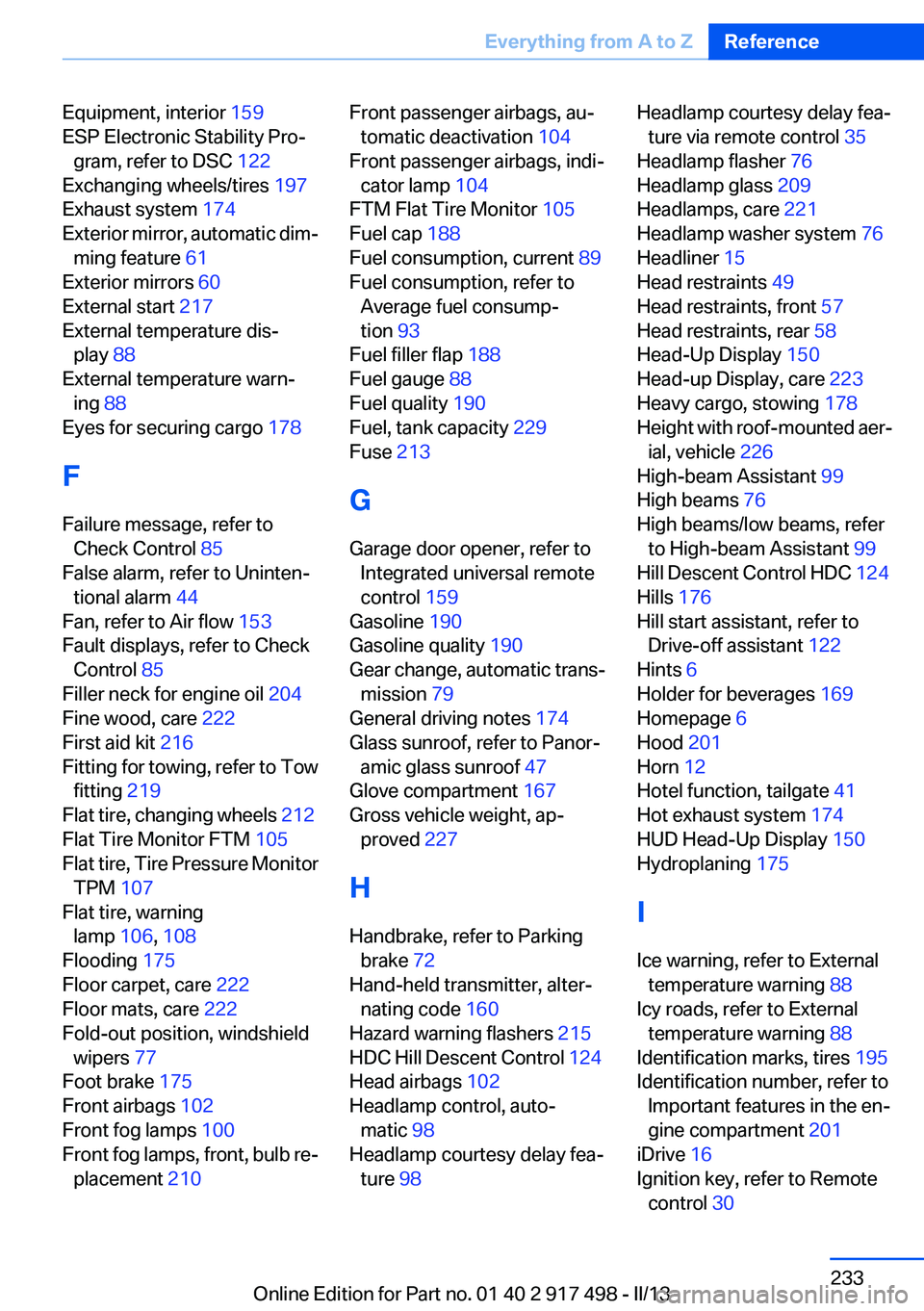
Equipment, interior 159
ESP Electronic Stability Pro‐ gram, refer to DSC 122
Exchanging wheels/tires 197
Exhaust system 174
Exterior mirror, automatic dim‐ ming feature 61
Exterior mirrors 60
External start 217
External temperature dis‐ play 88
External temperature warn‐ ing 88
Eyes for securing cargo 178
F
Failure message, refer to Check Control 85
False alarm, refer to Uninten‐ tional alarm 44
Fan, refer to Air flow 153
Fault displays, refer to Check Control 85
Filler neck for engine oil 204
Fine wood, care 222
First aid kit 216
Fitting for towing, refer to Tow fitting 219
Flat tire, changing wheels 212
Flat Tire Monitor FTM 105
Flat tire, Tire Pressure Monitor TPM 107
Flat tire, warning lamp 106, 108
Flooding 175
Floor carpet, care 222
Floor mats, care 222
Fold-out position, windshield wipers 77
Foot brake 175
Front airbags 102
Front fog lamps 100
Front fog lamps, front, bulb re‐ placement 210 Front passenger airbags, au‐
tomatic deactivation 104
Front passenger airbags, indi‐ cator lamp 104
FTM Flat Tire Monitor 105
Fuel cap 188
Fuel consumption, current 89
Fuel consumption, refer to Average fuel consump‐
tion 93
Fuel filler flap 188
Fuel gauge 88
Fuel quality 190
Fuel, tank capacity 229
Fuse 213
G
Garage door opener, refer to Integrated universal remote
control 159
Gasoline 190
Gasoline quality 190
Gear change, automatic trans‐ mission 79
General driving notes 174
Glass sunroof, refer to Panor‐ amic glass sunroof 47
Glove compartment 167
Gross vehicle weight, ap‐ proved 227
H
Handbrake, refer to Parking brake 72
Hand-held transmitter, alter‐ nating code 160
Hazard warning flashers 215
HDC Hill Descent Control 124
Head airbags 102
Headlamp control, auto‐ matic 98
Headlamp courtesy delay fea‐ ture 98 Headlamp courtesy delay fea‐
ture via remote control 35
Headlamp flasher 76
Headlamp glass 209
Headlamps, care 221
Headlamp washer system 76
Headliner 15
Head restraints 49
Head restraints, front 57
Head restraints, rear 58
Head-Up Display 150
Head-up Display, care 223
Heavy cargo, stowing 178
Height with roof-mounted aer‐ ial, vehicle 226
High-beam Assistant 99
High beams 76
High beams/low beams, refer to High-beam Assistant 99
Hill Descent Control HDC 124
Hills 176
Hill start assistant, refer to Drive-off assistant 122
Hints 6
Holder for beverages 169
Homepage 6
Hood 201
Horn 12
Hotel function, tailgate 41
Hot exhaust system 174
HUD Head-Up Display 150
Hydroplaning 175
I
Ice warning, refer to External temperature warning 88
Icy roads, refer to External temperature warning 88
Identification marks, tires 195
Identification number, refer to Important features in the en‐
gine compartment 201
iDrive 16
Ignition key, refer to Remote control 30 Seite 233Everything from A to ZReference233
Online Edition for Part no. 01 40 2 917 498 - II/13
Page 235 of 240
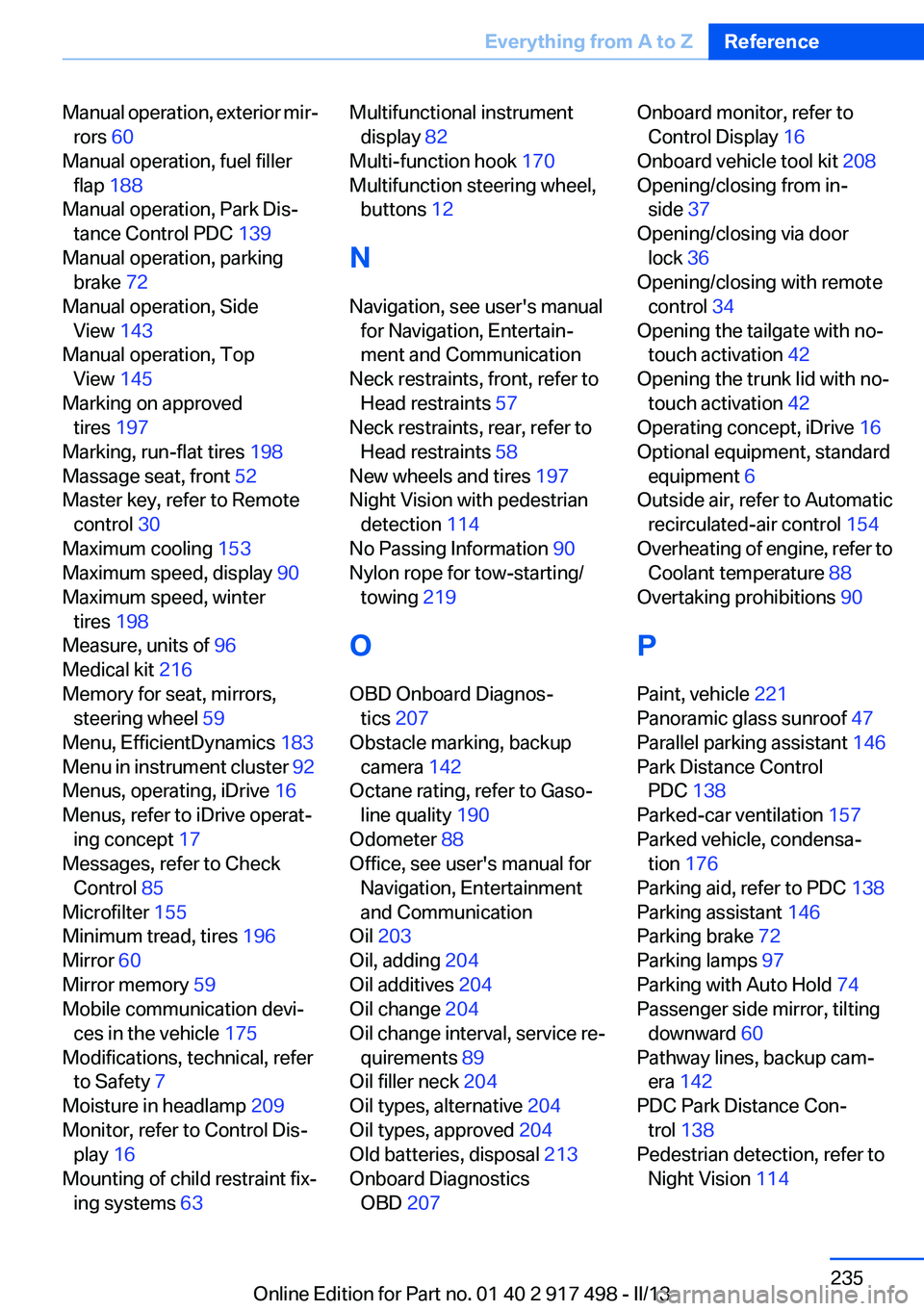
Manual operation, exterior mir‐rors 60
Manual operation, fuel filler flap 188
Manual operation, Park Dis‐ tance Control PDC 139
Manual operation, parking brake 72
Manual operation, Side View 143
Manual operation, Top View 145
Marking on approved tires 197
Marking, run-flat tires 198
Massage seat, front 52
Master key, refer to Remote control 30
Maximum cooling 153
Maximum speed, display 90
Maximum speed, winter tires 198
Measure, units of 96
Medical kit 216
Memory for seat, mirrors, steering wheel 59
Menu, EfficientDynamics 183
Menu in instrument cluster 92
Menus, operating, iDrive 16
Menus, refer to iDrive operat‐ ing concept 17
Messages, refer to Check Control 85
Microfilter 155
Minimum tread, tires 196
Mirror 60
Mirror memory 59
Mobile communication devi‐ ces in the vehicle 175
Modifications, technical, refer to Safety 7
Moisture in headlamp 209
Monitor, refer to Control Dis‐ play 16
Mounting of child restraint fix‐ ing systems 63 Multifunctional instrument
display 82
Multi-function hook 170
Multifunction steering wheel, buttons 12
N
Navigation, see user's manual for Navigation, Entertain‐
ment and Communication
Neck restraints, front, refer to Head restraints 57
Neck restraints, rear, refer to Head restraints 58
New wheels and tires 197
Night Vision with pedestrian detection 114
No Passing Information 90
Nylon rope for tow-starting/ towing 219
O
OBD Onboard Diagnos‐ tics 207
Obstacle marking, backup camera 142
Octane rating, refer to Gaso‐ line quality 190
Odometer 88
Office, see user's manual for Navigation, Entertainment
and Communication
Oil 203
Oil, adding 204
Oil additives 204
Oil change 204
Oil change interval, service re‐ quirements 89
Oil filler neck 204
Oil types, alternative 204
Oil types, approved 204
Old batteries, disposal 213
Onboard Diagnostics OBD 207 Onboard monitor, refer to
Control Display 16
Onboard vehicle tool kit 208
Opening/closing from in‐ side 37
Opening/closing via door lock 36
Opening/closing with remote control 34
Opening the tailgate with no- touch activation 42
Opening the trunk lid with no- touch activation 42
Operating concept, iDrive 16
Optional equipment, standard equipment 6
Outside air, refer to Automatic recirculated-air control 154
Overheating of engine, refer to Coolant temperature 88
Overtaking prohibitions 90
P
Paint, vehicle 221
Panoramic glass sunroof 47
Parallel parking assistant 146
Park Distance Control PDC 138
Parked-car ventilation 157
Parked vehicle, condensa‐ tion 176
Parking aid, refer to PDC 138
Parking assistant 146
Parking brake 72
Parking lamps 97
Parking with Auto Hold 74
Passenger side mirror, tilting downward 60
Pathway lines, backup cam‐ era 142
PDC Park Distance Con‐ trol 138
Pedestrian detection, refer to Night Vision 114 Seite 235Everything from A to ZReference235
Online Edition for Part no. 01 40 2 917 498 - II/13